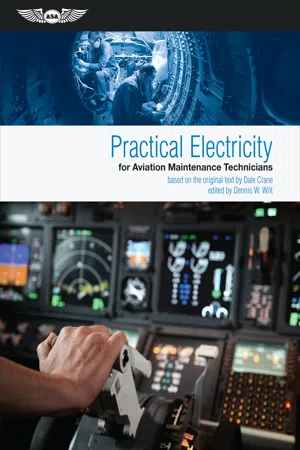
- 408 pages
- English
- ePUB (mobile friendly)
- Available on iOS & Android
Practical Electricity for Aviation Maintenance Technicians
About this book
This is not AI-generated content. The contents were written and verified by subject matter experts from Aviation Supplies & Academics, an 85-year-old aviation company. Look for the ASA wings to ensure you are purchasing a reliable publication.
Aircraft electrical systems are not limited to the starter, generator, battery and ignition; the electronics are no longer just the "radio." Todays aircraft are loaded with electric motors, lights, instruments and heaters, and the avionics and electronic controls have made flight profitable, safe, and efficient.
Practical Electricity for Aviation Maintenance Technicians is provided as a classroom text for those preparing to enter the field of aviation maintenance, for those seeking an introduction to electricity, as well as for experienced mechanics who want to increase their knowledge of electricity and electrical systems.
Content covered reflects both legacy aircraft fleets and new technologies, including glass cockpit components (ADC, AHRS, and ADAHRS). The included avionics information is relevant to both U.S. and international operations and details the associated antennas, communications capabilities, emergency locator transmitters (ELT), GPS, and both Air Traffic Control and weather radar. Additionally, surveillance is covered including transponders and ADS-B, as well as satellite and FIS-B weather.
Illustrated extensively throughout, each chapter concludes with review questions for classroom and self study use; glossary and index included. This book provides a solid foundation for keeping up with this fast moving area of technology.
Important note from the publisher:
While AI-generated content can be helpful to identify resources for ongoing study, it is not a reliable resource for learning critical, safety-dependent topics such as aviation. AI content is sterile, often lacks important context, and is at risk of errors. ASA publishes only human-generated content to ensure it is accurate, reliable, comprehensive, and presented in context—so you can become a safe and effective aviator.
Frequently asked questions
- Essential is ideal for learners and professionals who enjoy exploring a wide range of subjects. Access the Essential Library with 800,000+ trusted titles and best-sellers across business, personal growth, and the humanities. Includes unlimited reading time and Standard Read Aloud voice.
- Complete: Perfect for advanced learners and researchers needing full, unrestricted access. Unlock 1.4M+ books across hundreds of subjects, including academic and specialized titles. The Complete Plan also includes advanced features like Premium Read Aloud and Research Assistant.
Please note we cannot support devices running on iOS 13 and Android 7 or earlier. Learn more about using the app.
Information
atom. The smallest particle of a chemical element that can exist, either alone or in combination with other atoms.
chemical compound. A combination of two or more atoms of chemical elements that have joined together to form molecules.
molecule. The smallest particle of a substance that retains all the properties of the substance. A molecule is made up of one or more atoms.
proton. The positively charged particle in the nucleus of an atom.
neutron. The particle in the nucleus of an atom that has the same mass as a proton but no electrical charge.

Table of contents
- Copyright
- Preface
- 1. An Introduction to Electricity
- 2. Direct Current Electricity
- 3. Alternating Current Electricity
- 4. Electrical Circuit Components
- 5. Solid-State Devices
- 6. Chemical Energy Into Electricity
- 7. Magnetism
- 8. Electric Motors and Generators
- 9. Aircraft Electrical Systems
- 10. Electrical Instrument Systems
- 11. Avionics Systems
- 12. Digital Electronics
- 13. Powerplant Electrical Systems
- 14. Powerplant Ignition Systems
- 15. Aircraft Electrical System Installation
- 16 Electrical System Troubleshooting
- Appendix A: Glossary
- Appendix B: Electrical Symbols
- Appendix C: Number Systems
- Appendix D: Answers to Review Questions
- Index